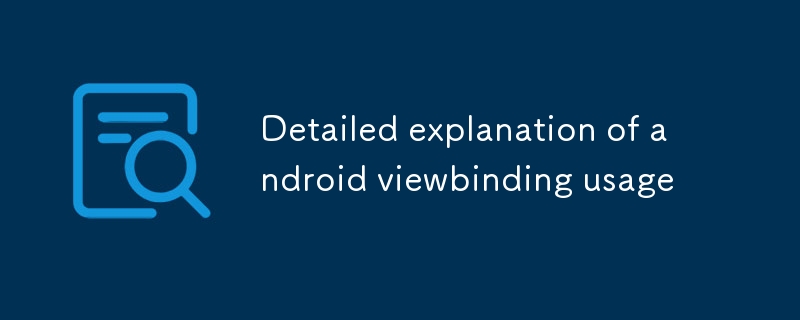Android viewbindingの使い方を詳しく解説
This article discusses performance optimizations for Android View Binding. It highlights techniques to minimize inflate operations, cache inflated views, use synthetic constructors, and leverage '<include>' tags. It also explores advant

Optimizing Android View Binding for Performance
To optimize Android View Binding for performance, consider the following techniques:
-
Avoid binding inflate operations in loops: Inflate operations can be expensive, so avoid calling
inflate()multiple times for the same layout. Instead, store the inflated object in a variable and reuse it as needed. - Cache inflated views: Once a view is inflated, cache it and reuse it instead of inflating it multiple times. This is especially beneficial for views that require complex initialization or are frequently displayed.
-
Use synthetic constructors: Android Studio can generate synthetic constructors for views, which can improve performance and reduce compile times. Enable synthetic access in your project's
gradle.propertiesfile by settingandroid.enableSelfDestruct=true. -
Consider using
<include>tags: If you have common UI elements that are used across multiple layouts, consider using<include>tags to reduce inflation overhead.
Advantages and Disadvantages of Android View Binding
Advantages:
- Improved code safety: View binding eliminates the need for findViewById() calls, reducing the risk of NullPointerExceptions and providing compile-time safety.
- Simplified code: View binding generates boilerplate code automatically, simplifying the layout process and reducing the amount of code you need to write.
- Enhanced performance: Compared to traditional findViewById() calls, view binding inflates layouts faster and avoids costly reflective calls.
Disadvantages:
- Increased binary size: View binding generates additional class files for each layout, which can increase the size of your APK.
- Limited flexibility: View binding is strongly tied to specific layouts, making it less flexible than manual findViewById() calls.
- Potential performance issues: Inflating complex layouts with many nested views can still lead to performance issues, even with view binding.
Handling Complex View Hierarchies with Android View Binding
To handle complex view hierarchies with Android View Binding:
- Use nested binding: Create a binding class for each child view and then nest them within a parent binding class. This allows you to access child views in the parent view's binding object.
- Split large layouts into fragments: If you have a particularly large or complex layout, consider splitting it into multiple fragments. This can improve performance and make it easier to manage.
- Utilize view binding delegates: Consider using libraries like ViewBindingDelegate or ButterKnife to delegate the creation of bindings to a separate class. This can help with performance and organization.
以上がAndroid viewbindingの使い方を詳しく解説の詳細内容です。詳細については、PHP 中国語 Web サイトの他の関連記事を参照してください。

ホットAIツール

Undresser.AI Undress
リアルなヌード写真を作成する AI 搭載アプリ

AI Clothes Remover
写真から衣服を削除するオンライン AI ツール。

Undress AI Tool
脱衣画像を無料で

Clothoff.io
AI衣類リムーバー

Video Face Swap
完全無料の AI 顔交換ツールを使用して、あらゆるビデオの顔を簡単に交換できます。

人気の記事

ホットツール

メモ帳++7.3.1
使いやすく無料のコードエディター

SublimeText3 中国語版
中国語版、とても使いやすい

ゼンドスタジオ 13.0.1
強力な PHP 統合開発環境

ドリームウィーバー CS6
ビジュアル Web 開発ツール

SublimeText3 Mac版
神レベルのコード編集ソフト(SublimeText3)

ホットトピック
 1670
1670
 14
14
 1428
1428
 52
52
 1329
1329
 25
25
 1276
1276
 29
29
 1256
1256
 24
24


